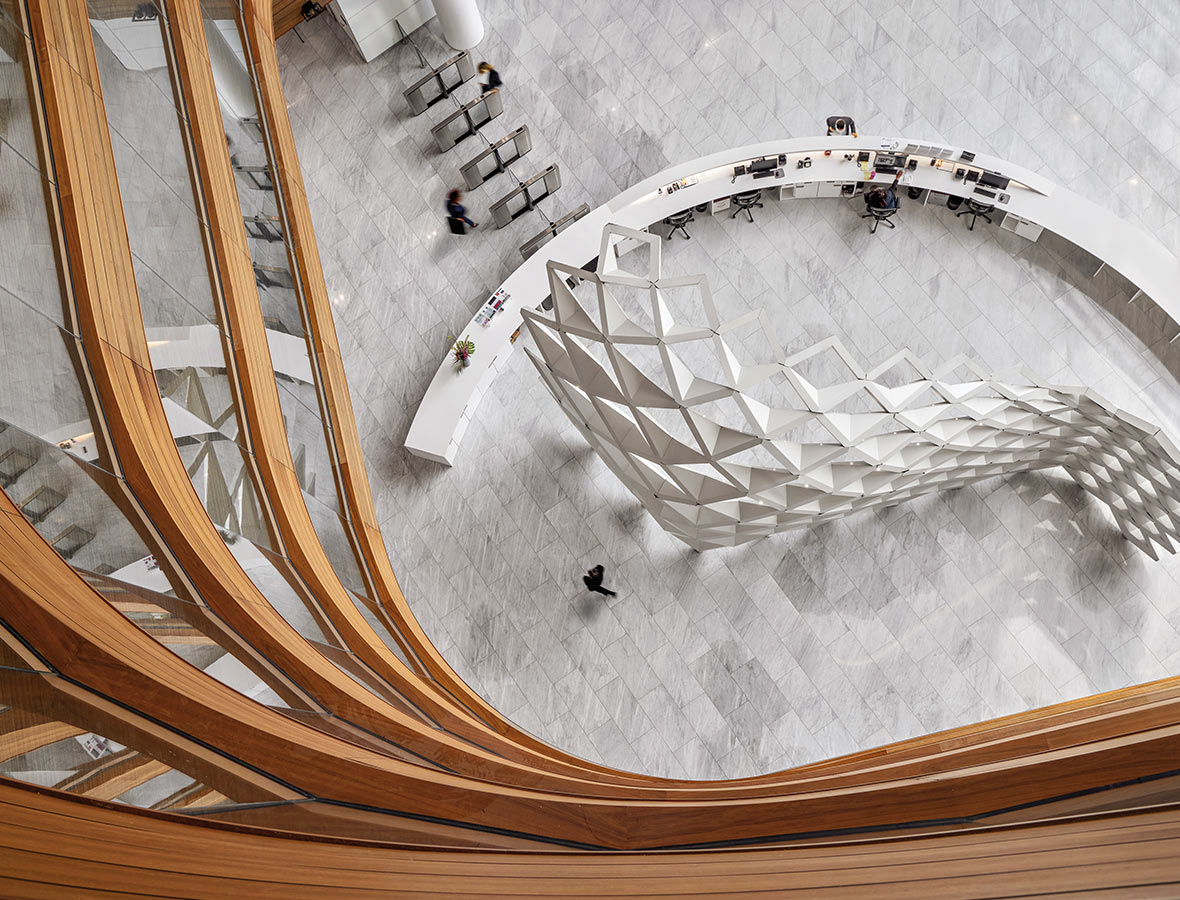Trends to Watch Shaping the Future of Wellness
March 14, 2024 | Q&A with Michael Schur and Stacey Olson
Editor’s Note: This blog is part of our Design Forecast blog series, looking at what’s next in 2024 and beyond.
Across industries, organizations are recognizing that to remain competitive and effective, wellness needs to be integrated into their physical environments and corporate cultures. We sat down with Michael Schur and Stacey Olson, global leaders for Gensler’s Wellness practice to discuss the trends shaping the future of the built environment, and hear why a holistic approach including wellness is needed to support a radically changing world.
Thinking across industries and the talent pool: how do companies remain competitive? What are ways that organizations can adapt to changing demographics, modalities, and create new opportunities?
Stacey Olson: Since the pandemic, people have been changing their lifestyles to support healthier living in a personal and holistic way. How that becomes realized in the built environment is starting to change. We’re starting to see more community-interfacing amenities, such as bathhouses, a rise in office park pickleball courts, and a growth in the organization of localized sports. It’s different for every person; every demographic. Individuals are finding ways to actively purse and embrace personal wellness, which trickles up to a demand on businesses to provide a holistic set of opportunities to meet those unique needs. It ties back to inclusive design thinking — acknowledging that everyone has unique needs, capabilities, motivations, and drivers for their own personal health.
Michael Schur: Building on the idea that individuals are finding wellness in their own way, wellness has also become a non-negotiable. We are seeing a greater focus on activities that prioritize mental, physical, emotional, and social well-being. There’s a realization that wellness isn’t a lifestyle choice; it’s pervasive across all dimensions of one’s life. It needs to be integrated into everything that we’re delivering if we want to thrive. Take real estate as an example. When we look at real estate that’s focused on wellness or has wellness components — whether it’s office space, retail, or hospitality — these are the areas where there are significant growth opportunities. The integration of wellness becomes a multiplier that is driving rent premiums, creating increased and faster lease rates, and spurring growth in markets that were otherwise stagnant.

Why look at wellness across various scales, from the individual to the community level?
Michael: Wellness works at various scales — from designing spaces that impact needs as personal and intimate as good sleep, to elements as comprehensive as lighting, clean air, and alignment of circadian rhythm that effects a multitude of user groups. Zooming out, wellness strategies are informing how amenity spaces can come together and create community in office, hospitality, education, and residential projects, and the role green space has within a community, city, or region. Good wellness strategy works at scales that aren’t just about the individual; they address the relationship of individuals to everything else around them.
Stacey: We’re focused on delivering wellness strategy in alignment the United Nations’ Sustainable Development Goals (SDGs). At the heart of those 17 goals are equity, resilience, and the health and well-being of all of mankind. Is it altruistic to think that we can design a better world, where people have improved health, well-being, safety, and a sustainable future? I don’t think so. When we think about designing with a wellness mindset, it has to extend beyond the individual and into the community.
Why is wellness an important consideration in workplace design, and what should organizations invest in to maximize workers’ health and well-being?
Michael: A recent Oxford study found that workplace wellness programs in the U.K. — from relaxation classes to well-being apps — were largely unsuccessful at changing people’s health and wellness outcomes. While the study has stirred debate, what we noted was that the study did not account for physical workplace interventions. If organizations or institutions are leveraging wellness programs in isolation — without looking at the greater context of the day-to-day needs of the individual — it makes sense that they’re less effective and not providing the intended impact. If you think about wellness as a system — consisting of physical space, programming, and other support programs that layer on top of the day-to-day — you’re going to be more successful.
According to our latest Workplace Performance Index (WPIx) research, high-performing workplaces have a greater array of choice amenities. Our data shows that physical space focused on wellness programming supports high-performing teams, worker satisfaction, and all the levers that companies need to stay competitive. It isn’t just about an ergonomic desk or a variety of workstation configurations, or the need for outdoor space, or areas dedicated to socialization, respite, and retreat. For people to be successful, they need all of the variety that these kinds of spaces, programs, and amenities offer. These things work in combination, not isolation.

How can design help connect and support multiple generations in the workplace?
Michael: From a design standpoint, it is very much about inclusivity, and making sure that people’s basic needs are addressed. This includes spaces that support intellectual wellness, emotional wellness, physical capability, and mental well-being. By designing to the edges — whether it’s younger or older generations — you’re able to capture the needs of the middle in new and interesting ways.
Stacey: We think about simple design strategies like tonal contrast; making sure that regardless of your capacity for eyesight or general wayfinding, that a space is easy to navigate. Similarly, using DeafSpace principles, we need to ask: Do we have blind corners? Do we have barriers within the physical space that make it more challenging for different generations to navigate? Do certain spaces exclude certain people? This is low-hanging fruit. When we can build in thoughtful, inclusive design strategies, all groups benefit. For example, when designing for sensory-sensitive or neurodiverse populations and we create a balance of spaces that include quiet rooms, meditation rooms, prayer rooms, or wellness rooms — we create co-benefits that serve all populations using the space.
What is “psychological safety,” and why is it essential in the workplace? What does this look like from a wellness design implementation perspective?
Stacey: Psychological safety is the idea that every person within an organization feels a certain level of trust, insofar that they won’t be judged, humiliated, or face backlash for contributing to the organization in a meaningful and authentic way. It’s the idea that they have the ability to speak, and to be heard. They feel emotionally secure, and they know they aren’t going to suffer negative ramifications when they participate. Organizations that have good psychological safety are more innovative, more resilient, and weather tough challenges more effectively. We can support a culture of wellness by designing physical space that cultivates trust.
Michael: It’s important to think about how to create psychological safety through the workplace culture, while also thinking about how the physical design of the space supports that culture. It comes back again to inclusive design, and making sure that people feel like they’re included and there are opportunities for them.
Stacey: Well-being, trust, collaboration, and innovation are fostered in teams and organizations when individuals feel comfortable in being vulnerable, sharing ideas, and engaging in open discussion. Design can cultivate these kinds of environments. This past summer, our summer fellows dissected color theory, highlighting warm colors for their promotion of social interaction and collaboration, while cool colors tend to create a sense of calm and focus. In addition to color theory, simple interventions like fostering comradery through collaboration zones or creating refuge spaces for retreat can increase the sense of psychological safety within an organization.
For media inquiries, email .


